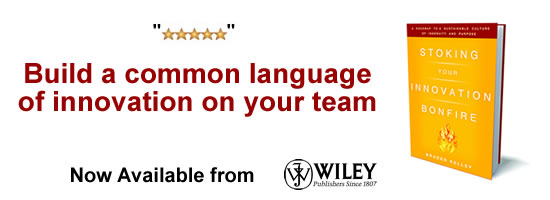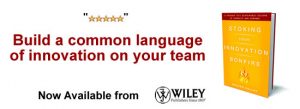Double Your Creativity with ONE Simple Step

“If I had an hour to solve a problem and my life depended on the solution, I would spend the first fifty-five minutes determining the proper question to ask, for once I know the proper question, I could solve the problem in less than five minutes.” — Albert Einstein
You would think by publishing a book entitled Winning the Brain Game that I’m a neuroscientist, psychiatrist or psychologist. I’m none of those. I spend a good part of my professional life as a facilitator, helping work teams solve their toughest problems in creative ways.
Several years ago I had the opportunity to help a very special team, the Los Angeles Police Department bomb squad.
It was a few years after 9/11, and LAPD Counterterrorism Command under then-chief William Bratton had selected 12 of the best and brightest bomb handlers and charged them with rethinking and redesigning the way bomb threats were handled in the field in the new age of improvised explosive devices.
Now this wasn’t a “hey, can you come out and help us do some brainstorming,†kind of thing, this was “we have a serious problem, and failure is not an option.†As part of the vetting process I had to meet with the department psychiatrist, a very serious gent, who let me know in no uncertain times that whatever skills I had — and whatever confidence I might have in those skills — would be put on trial by this particular team: they were a breed apart…an extreme team, high ego, high adrenalin, mostly type A, among the highest paid, and not so thrilled about being locked up for two days with some civilian who knows nothing about the job.
While I was absolutely thrilled to be involved, he was right. I’ll never forget that first morning when the young officer sitting next to me leaned over to inform me — hand on his holster — that he was only there because he was ordered. I caught enough heads nodding to know he wasn’t expressing a minority view.
I always start my sessions with a little right brain warmup. But with this team, I knew I’d need something more potent than your run of the mill icebreaker.
So I put ’em all in handcuffs. Not real ones of course, just some I had made out of rope. I had found this hundred year old parlor game called “The Prisoner’s Release.†Seemed appropriate.
A and B must free themselves without removing, replacing or untying the handcuffs.
In other words, the handcuffs must stay on original hands at all times.
Now, I’d been using this little thought challenge for a while for the simple reason that it’s nowhere near as difficult as the problems people face in their real work, but it catches them doing several things that get in the way of creative problem solving.
You could tell they thought this was a no-brainer. So I gave them five minutes. I can’t show you what happened that particular day, but what I can do is show you what ALWAYS happens when I say go.
I promise the bomb squad looked no different, and no one solved the problem. Which is at least a little surprising given what you’d think would be a certain facility with handcuffs. I think they were all a little stunned too.
But over the last 10 years I’ve done this exercise with thousands of people, all over the world. The action is always the same. The results are always the same: success rate is about 5%…1 in twenty pairs solve it within that time limit.
The question is, why is that?
The short answer is that our brain plays games with us, and it does that using the very same well-worn patterns that on one hand help us make it through the day efficiently, but that on the other hand can trip us up when we need to tap the power of our mind to produce our very best thinking.
And just in case you didn’t catch what I did there, I just made a distinction between the brain and the mind.
That’s not just me, that’s current science. We now know the biological brain is like passive hardware, absorbing experience, and the conscious mind is like active software, directing our attention. But not just any software — it’s software capable of rewiring the hardware. That’s the marvel of what’s called neuroplasticity.
LEAPING
The most prevalent brain game that I have observed is what I call Leaping. Short for leaping to solutions, aka jumping to conclusions, aka thin-slicing, aka “blinking.†Everyone in the clip above does it. EVERYONE. When I say “go†everyone starts string dancing. They spend all their time brainstorming…or more accurately, bodystorming.
Leaping to solutions is our go-to problem solving process, but all the research is clear: jumping right into brainstorming when handed a tough and unfamiliar problem is only good for one thing…generating obvious, top-of-mind, mediocre ideas that generally don’t solve the problem. As the string-dancers so gloriously manifest.
So let’s see how this works…
Take a look at this incorrect Roman numeral equation.
XI + I = X
Obviously eleven plus one does not equal ten. Now imagine that the numbers are movable sticks. Leaving the plus and equal signs locked and UNmovable, what is the least number of sticks you would have to move to correct the equation?
Most people answer “1†within a millisecond. Repositioning one of the vertical sticks is the obvious answer.
But wait. Revisit the question. What would be the optimal or ideal answer to “least number of sticks?†Answer: zero.
Is that possible?
Sure, there are at least three ways, by pausing for a moment to look at the problem differently, from other perspectives. By looking at the problem upside down, or by reading the equation literally right to left, or if you recognize the visual symmetry, reflect it in a mirror.
WHY WE LEAP
There are good reasons we instinctively leap. One is that most of the problems we solve each day are of a routine nature: you know, what to wear today, is it tall, grande, venti, what’s the quickest way to work…we don’t want or need to meditate on why traffic is slow, we just need a workaround.
Neuroscientists maintain that we jump to conclusions because of uncertainty. The brain hates uncertainty. When we are unsure of a situation we link cause and effect like that, and often in error.
But we aren’t born with that reflex. We learned and developed it. In school, we learned to get the right answer on a timed test. Uncertainty meant failure. We bring that mindset with us to our job, which makes our boss happy, just like it made our teachers happy. By the time we’re 18, we’re wizards of the leap. Given our grooming, it is no wonder that we leap to solutions whenever we’re faced with an unfamiliar problem that requires creative thinking and problem solving. But when we leap, we often lose, because we effectively close off the creative part of our brain before it even has a chance to get involved.
Because we solve so many of our problems that way, we naturally and intuitively apply that approach to problems that DO require deeper thinking.
THE FIX: FRAMESTORMING
What gets in the way of everyone in the room solving the handcuff challenge inside 5 minutes (yes, it is easily solved) is the universal tendency to let our lazy brains take over and leave our minds out of it.
Over the past few years I’ve been embedding a “ringer†pair in the handcuff challenge: I secretly instruct one pair to do nothing for the first 60 seconds other than study the situation, observe the action around them, and then approach the remaining time by considering one question: “How might Einstein solve the problem?â€
I use that question because most people are familiar with Einstein’s famous quote, “If I had an hour to solve a problem, I’d spend the first 55 minutes determining the proper question to ask, for once I know the proper question, I could solve the problem in less than five minutes.â€
The effect is magical, and the action is a complete reversal: NO string dancing whatsoever, coupled with far more dialogue devoted NOT to solutions, but rather why the string-dancing going on around them isn’t working. Attention is far more attuned…they look more like chess players studying the board. They quickly realize the double loop nature of the problem.
And the results are amazing. It’s actually kind of freaky: they solve it close to 95% of the time and well within the 5-minute mark. And when they don’t, it’s usually an issue of not playing well with others, which is a topic for another day.
What the Einstein question effectively does is to quickly inject the one easy step that can unlock creativity: reframing. It promotes a pause that enables the mind to consider different perspectives.
If I have learned anything from facilitating problem-solving sessions, it is that we will be largely unsuccessful in attempting to shut off the Leaping impulse, and we should not even try. We will make far more progress if we instead redirect and channel the instinct to act into behavior that feels like brainstorming, but involves generating questions instead of answers.
It’s called framestorming, a mashup of framing and brainstorming. It’s a way to change behavior without the pain of change, and it works amazingly well. The ability to properly frame an issue or problem goes far in avoiding the typical pitfalls that limit our ability to reach creative, elegant solutions. But we’re not as good at it as we could be, for reasons cited above.
Framestorming is done right before brainstorming. The major difference is that the focus of framestorming is on generating questions, not solutions.
The power of framestorming lies in its ability to turn problems into puzzles. When we view something as a problem, we naturally engage in Leaping to solutions. When something is a puzzle, though, we naturally slow down a bit: we learn at an early age when doing puzzles that we need to get the corners and edges down first. Getting the puzzle frame right is half the battle!
Here’s how it works:
Step 1: Generate Questions
When faced with an unfamiliar problem, generate as many questions as you can, using constructs such as “Why____?†“What if_____?†“How might we_____?†My favorite is the last one, and it’s the one I adapted for ringer pairs in the handcuff challenge. (Note: The word “might†is important, because it implies possibility. Avoid “how could†or “how should†constructs, because “could†implies capability, and “should†implies judgment, both of which can shunt creative thought.)
As in brainstorming, framestorming initially favors quantity over quality. Go for at least a dozen questions that frame the challenge, preferably more. Don’t stop until you’re well into the double digits.
Take the advice of Albert Einstein:
“Life is like riding a bicycle. To keep your balance you must keep moving.” — Albert Einstein
Step 2: Pick Your Top Two
Once you have a master list of frames, you can select at least two that will launch you into the solution brainstorming mode, which is essentially another round of the Why? What if? How? questions, this time focused on answers. From there, you know what to do!
You should be aware that framestorming, while being a powerful antidote to Leaping, does not guarantee the elegant solution, but it will increase the odds of putting your best brain forward. And based on a decade of observation, it will at least double your creative output.
EPILOGUE
The handcuff exercise did indeed loosen things up with the LAPD bomb squad. That officer next to me became the quiet leader in the room. In the end, they created an altogether new, far more fluid way to respond to bomb threats, and it became the new LAPD standard.
Would they have done so without my help? Probably. But I like to think I contributed in some small way by unlocking their brains and opening their minds to speed the process up a bit.
The takeaway lesson is this: always framestorm before you brainstorm.
EDITOR’S NOTE: I am excited to say that I’ll have the honor of bringing you an exclusive interview with Matt about his latest book Winning the Brain Game very soon!
Wait! Before you go…
Choose how you want the latest innovation content delivered to you:
- Daily — RSS Feed — Email — Twitter — Facebook — Linkedin Today
- Weekly — Email Newsletter — Free Magazine — Linkedin Group
 Matthew E. May is the author, most recently, of Winning the Brain Game: Fixing the 7 Fatal Flaws of Thinking.
Matthew E. May is the author, most recently, of Winning the Brain Game: Fixing the 7 Fatal Flaws of Thinking.
NEVER MISS ANOTHER NEWSLETTER!
LATEST BLOGS
Starbucks and Big Tobacco
Back in the 1950’s smoking was glamorous, and just about everybody who was anybody smoked cigarettes. Then came the discovery, to the shock of millions, that sucking smoke into your lungs might not be good for you. Then came another revelation that one of the substances in tobacco, nicotine, which was used as a poison by the Egyptians during the times of the Great Pyramids, is addictive. People then began a mass exodus from the consumption of nicotine via inhaled smoke.
Read MoreWal-Mart Goes Green – What about your company?
With the price of gas above $3.00, some companies (and hopefully all) are beginning to look at the fuel efficiency of their fleets. Wal-Mart is the most public example of this with its trucking fleet. Its efforts include:
Read More



